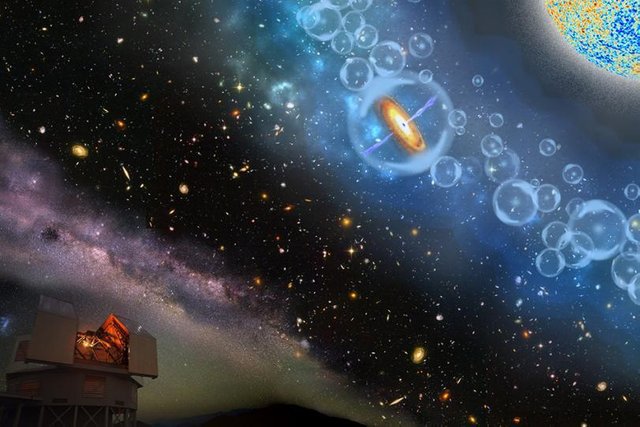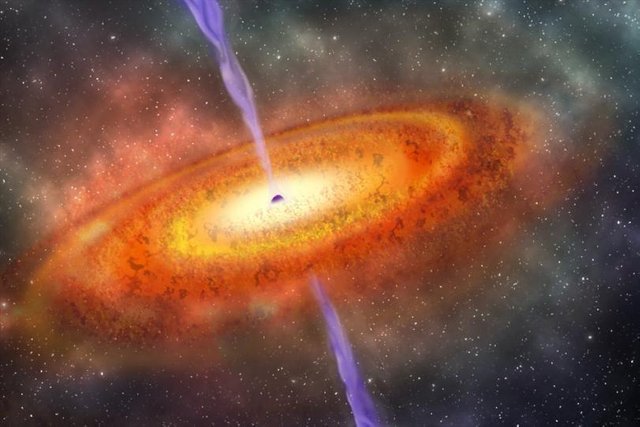
Scientists have no explanation for how a supermassive black hole existed a mere 690 million years after the Big Bang brought the universe into existence. But now that they have found one nestled inside a quasar, there could be dozens more of these ancient and massive objects in the skies around us.
The discovery, announced Wednesday, was of a supermassive black hole with 800 million solar masses which resides in a bright quasar, the light from where took 13 billion years to reach Earth. That mass is not unusual for supermassive black holes, but it is difficult to explain — using current black hole formation theories — how it came together at such an early time in the universe’s history.
“Gathering all this mass in fewer than 690 million years is an enormous challenge for theories of supermassive black hole growth,” Eduardo Bañados, an astronomer at the Carnegie Institute for Science and lead author of the research, said in a press release Wednesday.
The universe is thought to be about 13.7 billion years old, meaning this supermassive black hole and quasar existed when the universe was in its infancy or only 5 percent of its current age. At that time, space was undergoing the epoch of re-ionization — turning from a largely opaque medium to one in which light could travel freely, making it visible.
“This is the only object we have observed from this era. It has an extremely high mass, and yet the universe is so young that this thing shouldn’t exist. The universe was just not old enough to make a black hole that big. It’s very puzzling,” Robert Simcoe from Massachusetts Institute of Technology’s Kavli Institute for Astrophysics and Space Research, who was a coauthor on the research, said in a statement Wednesday.
The quasar, named J1342+0928, was spotted at a redshift of 7.54 (only one more quasar with a redshift over 7 had been found before). Redshift refers to the lengthening of the wavelength of light from an object, caused by the Doppler effect as the universe expands. It allows astronomers to calculate how far a distant object in space is.
While the discovery challenges present-day notions of how black holes form, scientists also predict that between 20 and 100 quasars, as bright and as old as the one announced Wednesday, exist in the universe. So the discovery may only be the first of its kind, and more findings are expected with improvements in technology.
“With several next-generation, even-more-sensitive facilities currently being built, we can expect many exciting discoveries in the very early universe in the coming years,” Daniel Stern of NASA’s Jet Propulsion Laboratory in Pasadena, California, also a coauthor on the paper, said in another statement.

ome future discoveries could be even older than the current one, and while they will still flummox scientists to explain their very existence, they could possibly be contained within the standard cosmological model. After all, the first stars and galaxies already existed at the time. However, that model would begin to be grossly insufficient if we were to discover primordial black holes — hypothetical gravity wells that existed before the first stars formed.
A recent research paper that proposed verifying the existence of these primordial black holes using gravitational waves also put a hard limit on how far back in time they could be. That limit was calculated at 65 million years after the Big Bang when the universe was less than a tenth the age at which J1342+0928 came around.
Bañados and his colleagues published a paper, titled “An 800-million-solar-mass black hole in a significantly neutral Universe at a redshift of 7.5,” in the journal Nature.
Not indicating that the content you copy/paste is not your original work could be seen as plagiarism.
Some tips to share content and add value:
Repeated plagiarized posts are considered spam. Spam is discouraged by the community, and may result in action from the cheetah bot.
Creative Commons: If you are posting content under a Creative Commons license, please attribute and link according to the specific license. If you are posting content under CC0 or Public Domain please consider noting that at the end of your post.
If you are actually the original author, please do reply to let us know!
Thank You!
More Info: Abuse Guide - 2017.
Downvoting a post can decrease pending rewards and make it less visible. Common reasons:
Submit
Hi! I am a robot. I just upvoted you! I found similar content that readers might be interested in:
http://www.ibtimes.com/oldest-known-supermassive-black-hole-quasar-may-have-dozens-undiscovered-companions-2625100
Downvoting a post can decrease pending rewards and make it less visible. Common reasons:
Submit